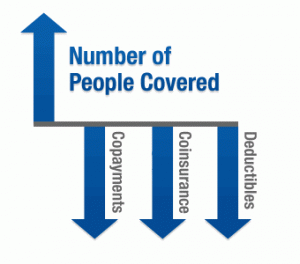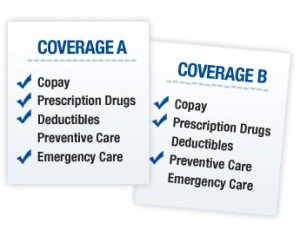 Significant changes in the U.S. healthcare system will occur in 2013 and 2014 under the Patient Protection & Affordable Care Act (which some call “Obamacare”). These changes are made by the law with the stated goals of:
Significant changes in the U.S. healthcare system will occur in 2013 and 2014 under the Patient Protection & Affordable Care Act (which some call “Obamacare”). These changes are made by the law with the stated goals of:
- Improving quality of care and lowering costs of care;
- Increasing access to affordable care; and
- Implementing new Consumer Protections;
The U.S. Department of Health & Human Services (HHS), which is charged with implementing and administering the law, provides detailed information about the law, its provisions, the timeline for implementing the new provisions, and how the law benefits you. This information is found on the HHS website HealthCare.gov.
Following is a portion of the Timeline provided on HealthCare.gov, showing some of the principal changes that will go into effect under the Health Care Law in 2013 and 2014:
2013
IMPROVING QUALITY AND LOWERING COSTS
- “Improving Preventive Health Coverage. To expand the number of Americans receiving preventive care, the law provides new funding to state Medicaid programs that choose to cover preventive services for patients at little or no cost. Effective January 1, 2013. Learn more about the law and preventive care.
- Expanding Authority to Bundle Payments. The law establishes a national pilot program to encourage hospitals, doctors, and other providers to work together to improve the coordination and quality of patient care. Under payment “bundling,” hospitals, doctors, and providers are paid a flat rate for an episode of care rather than the current fragmented system where each service or test or bundles of items or services are billed separately to Medicare. For example, instead of a surgical procedure generating multiple claims from multiple providers, the entire team is compensated with a “bundled” payment that provides incentives to deliver health care services more efficiently while maintaining or improving quality of care. It aligns the incentives of those delivering care, and savings are shared between providers and the Medicare program. Effective no later than January 1, 2013.
INCREASING ACCESS TO AFFORDABLE CARE
- Increasing Medicaid Payments for Primary Care Doctors. As Medicaid programs and providers prepare to cover more patients in 2014, the Act requires states to pay primary care physicians no less than 100% of Medicare payment rates in 2013 and 2014 for primary care services. The increase is fully funded by the federal government. Effective January 1, 2013. Learn how the law supports and strengthens primary care providers.
- Providing Additional Funding for the Children’s Health Insurance Program. Under the law, states will receive two more years of funding to continue coverage for children not eligible for Medicaid. Effective October 1, 2013. Learn more about CHIP.
2014
 NEW CONSUMER PROTECTIONS
NEW CONSUMER PROTECTIONS
- Prohibiting Discrimination Due to Pre-Existing Conditions or Gender. The law implements strong reforms that prohibit insurance companies from refusing to sell coverage or renew policies because of an individual’s pre-existing conditions. Also, in the individual and small group market, the law eliminates the ability of insurance companies to charge higher rates due to gender or health status. Effective January 1, 2014. Learn more about protecting Americans with pre-existing conditions.
- Eliminating Annual Limits on Insurance Coverage. The law prohibits new plans and existing group plans from imposing annual dollar limits on the amount of coverage an individual may receive. Effective January 1, 2014. Learn how the law will phase out annual limits by 2014.
- Ensuring Coverage for Individuals Participating in Clinical Trials. Insurers will be prohibited from dropping or limiting coverage because an individual chooses to participate in a clinical trial. Applies to all clinical trials that treat cancer or other life-threatening diseases. Effective January 1, 2014.
IMPROVING QUALITY AND LOWERING COSTS
- Making Care More Affordable. Tax credits to make it easier for the middle class to afford insurance will become available for people with income between 100% and 400% of the poverty line who are not eligible for other affordable coverage. (In 2010, 400% of the poverty line comes out to about $43,000 for an individual or $88,000 for a family of four.) The tax credit is advanceable, so it can lower your premium payments each month, rather than making you wait for tax time. It’s also refundable, so even moderate-income families can receive the full benefit of the credit. These individuals may also qualify for reduced cost-sharing (copayments, co-insurance, and deductibles). Effective January 1, 2014. Learn how the law will make care more affordable in 2014.
- Establishing Affordable Insurance Exchanges. Starting in 2014 if your employer doesn’t offer insurance, you will be able to buy it directly in an Affordable Insurance Exchange. An Exchange is a new transparent and competitive insurance marketplace where individuals and small businesses can buy affordable and qualified health benefit plans. Exchanges will offer you a choice of health plans that meet certain benefits and cost standards. Starting in 2014, Members of Congress will be getting their health care insurance through Exchanges, and you will be able buy your insurance through Exchanges too. Effective January 1, 2014. Learn more about Exchanges.
- Increasing the Small Business Tax Credit. The law implements the second phase of the small business tax credit for qualified small businesses and small non-profit organizations. In this phase, the credit is up to 50% of the employer’s contribution to provide health insurance for employees. There is also up to a 35% credit for small non-profit organizations. Effective January 1, 2014. Learn more about the small business tax credit.

INCREASING ACCESS TO AFFORDABLE CARE
- Increasing Access to Medicaid. Americans who earn less than 133% of the poverty level (approximately $14,000 for an individual and $29,000 for a family of four) will be eligible to enroll in Medicaid. States will receive 100% federal funding for the first three years to support this expanded coverage, phasing to 90% federal funding in subsequent years. Effective January 1, 2014. Learn more about Medicaid.
- Promoting Individual Responsibility. Under the law, most individuals who can afford it will be required to obtain basic health insurance coverage or pay a fee to help offset the costs of caring for uninsured Americans. If affordable coverage is not available to an individual, he or she will be eligible for an exemption. Effective January 1, 2014. Learn more about individual responsibility and the law.
IMPROVING QUALITY AND LOWERING COSTS
- Paying Physicians Based on Value Not Volume. Effective January 1, 2015, a new provision will tie physician payments to the quality of care they provide. Physicians will see their payments modified so that those who provide higher value care will receive higher payments than those who provide lower quality care.”
2012 in Review
For a review of what was done in 2012 by the U.S. Department of Health & Human Services (HHS), see the following video released by HHS on December 31, 2012:
More Information
For more news and information about the Patient Protection & Affordable Care Act, President Obama’s signature Health Care Law, and about health care reform, see the HelpingYouCare® resource pages on VoicesForCare™, including:
- News on Health Care Reform;
- Editorials: What Needs Improvement, With Your Comments;
- Advocacy: Proposals for Reform, With Your Comments;
- Legislation: Pending & Recently Adopted; and
- International Health Care Compare: Information on Health Care & Long-Term Care Solutions in Other Countries.
_____________
Copyright © 2013 Care-Help LLC, publisher of HelpingYouCare®. All rights reserved.












Recent Comments from our Online Community